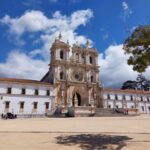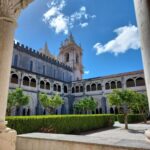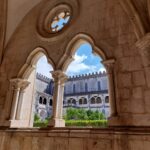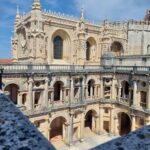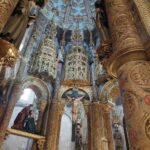Alcobaça has the largest church in Portugal. The Mosteiro de Santa Maria. In this monastery are buried Pedro, son of Alfonso IV and his lady-in-waiting, Ines Castro, each in their own stone tomb. A love story! The Romeo and Juliet story of Portugal.
Their love story is very famous. Pedro, son of King Afonso IV, would marry the Galician Constança. She came to the Portuguese court with her lady-in-waiting, Inês. Pedro and Inês fell madly in love with each other. This alarmed Afonso IV that he decided to send Inês back to Burgos. Pedro and Constança got married, but Pedro couldn’t forget Inês.
When Constança died, Pedro and Inês got together again, and they secretly married. Together they had 4 children. Afonso IV, could not accept it and ordered the death of Inês; she was beheaded by knights. Pedro was furious and wanted revenge. When Pedro became king, he brought to trial the knights that killed Ines. He was able to catch only two of them, the third one took refuge in France. He sentenced them to death and he ripped their hearts out with his own hands to pay for what they did to his beloved Ines. Also, he took the decaying body of Ines from the ground he dressed her in royal clothes and ask everyone to kiss her hand and recognize her as queen. After he buried her in the stone tomb he prepared for her. At Pedro’s command, his own stone tomb was placed right in front of Inês, so that when they met eachother again on Judgment Day, they can look each other in the eye again. It is said that her spirit still roams in the church to this day.
In addition, Alcobaça is known for its pottery and its delicious pastries. One pastry is even sweeter than the other. Three pastry shops in the town try to offer the most delicious pastries and try to outdo each other during the annual national awards ceremony. The city exudes a special atmosphere, as if you step back in time. There are narrow streets you can walk through and there is an almost serene peace. You can enjoy the sun, drink on the nice terraces or enjoy tasty food in one of the restaurants.
You can also visit the market in the city center or the wine museum. The Museu da Junta Nacional do Vinho is considered one of the jewels of the national wine heritage. It is housed in a former wine cellar from 1874. The museum’s collection is the most extensive in the country, containing over 8,500 pieces in the fields of winemaking, ethnology, traditional technology, and graphic and decorative arts. Guided visits are possible every hour. The tour ends with a small winetasting.
Discover more
